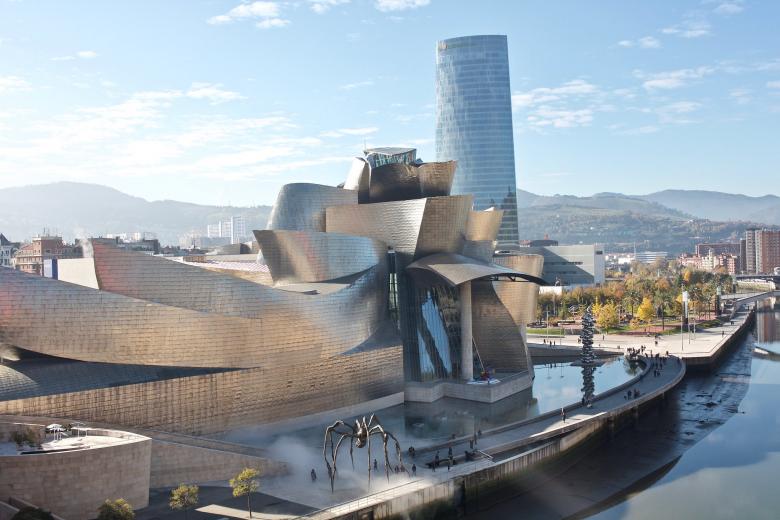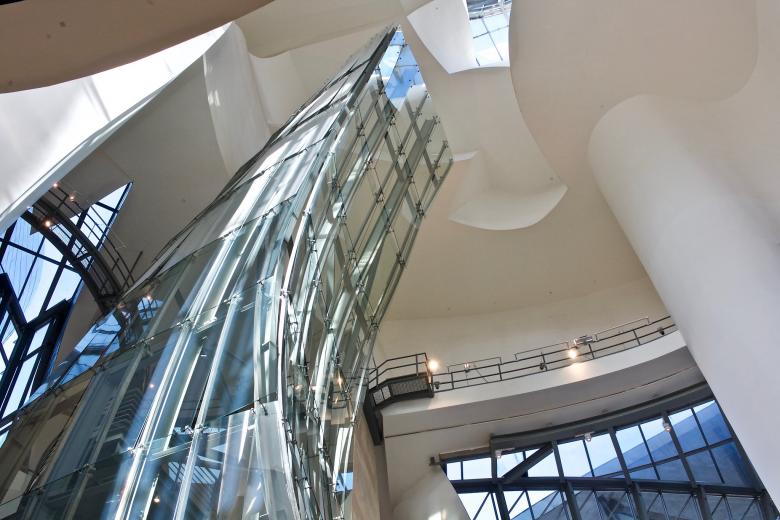14. June 2023
Photo: Naotake Murayama/Flickr/CC BY 2.0)
As announced on Friday, June 9, when architects were gathering in San Francisco for the AIA Conference on Architecture, Frank Gehry's iconic, game-changing Guggenheim Museum Bilbao is the latest recipient of the AIA's Twenty-five Year Award.
The only thing surprising about the Guggenheim Museum Bilbao winning this award from the American Institute of Architects (AIA) is that it didn't happen last year. That was when the museum, completed in 1997, was first eligible for the Twenty-five Year Award, which recognizes “a building that has stood the test of time for 25-35 years and continues to set standards of excellence for its architectural design and significance.” The award is the highest honor from the AIA given to an individual project, and, since the jury decided in 2018 to forego an award, each year its naming brings a slight amount of anticipation as well as scrutiny. But Frank Gehry's Guggenheim Bilbao — one of the few contemporary buildings that needs no introduction to anyone, architect or otherwise — is an obvious recipient, its selection merely a matter of when, not if.
A press release from the AIA says this, in part, about the significance of the flowing, titanium-clad building: “The Guggenheim Museum Bilbao stands as an enduring testament to creativity, innovation, and collaboration between three entities — architect Frank O. Gehry; client Solomon R. Guggenheim Foundation; and host city Bilbao — who all worked together to create something extraordinary out of necessity and opportunity. The result is a timeless architectural masterpiece that continues to inspire people around the world today almost 25 years after its completion.”
Curiously, neither the press release nor the project page on the AIA website mention the famous and much-repeated “Bilbao Effect,” in which an iconic piece of architecture would be able to draw people from around the world, effectively transforming an industrial city into a cultural destination. While the museum was built at the same time as major infrastructural projects, such as an airport, train station, and subway, and therefore was hardly acting alone in Bilbao's late 20th-century transformation, it immediately became the symbol of the city and the “effect” named after it. As such, cities around the world found it “necessary to have an iconic spectacular building, usually designed by a famous architect, to anchor urban megaprojects,” according to Leslie Sklar, author of The Icon Project: Architecture, Cities, and Capitalist Globalization. Even Gehry, as quoted in Davide Ponzini's Starchitecture, lamented how “people come to my office and want to hire me to do the Bilbao effect.”
- 2022: Chapel of St. Ignatius, Steven Holl Architects, 1997
- 2021: Burton Barr Phoenix Central Library, Will Bruder, 1995
- 2020: "Conjunctive Points–The New City," Eric Owen Moss, begun 1986
- 2019: Sainsbury Wing at the National Gallery, VSBA, 1991
- 2018: No award given (This decision led us to attend a seminar at the AIA Conference that year to learn how a winner is selected — or not.)
- 2017: Louvre Pyramid, I.M. Pei, 1989
Photo: Naotake Murayama/Flickr/CC BY 2.0)
Fast forward 26 years to 2023, when the concerns of the profession and wider architectural culture are focused on sustainability and the circular economy, diversity and marginalized voices, social and affordable housing, social justice and just about any concern other than the creation of architectural icons, it seems hard to fully agree with the jury* that Gehry's Guggenheim Museum Bilbao “continues to inspire people around the world today.” It is, in many ways, a symbol of another era. Nevertheless, there has not been a single work of architecture built in the last 25 to 35 years that has had the outsized impact of Gehry's museum. As such, it must receive this award from the AIA, no matter how it's citation is worded.
Still, it's worth comparing Gehry's museum to his previous Twenty-five Year Award: his own house in Santa Monica, California, awarded in 2012. That bold renovation of a traditional bungalow, which he started working on for his family in 1978, was celebrated for its jarring juxtapositions between new and old and the unconventional uses of off-the-shelf materials like chain-link fencing. It was included as one of the few built examples of “Deconstructivist Architecture” in MoMA's 1988 exhibition of that name, though, like the Bilbao effect, Gehry would try to distance himself from the label. Today, with every building considered from the point of view of its embodied energy and/or embodied carbon, his diminutive house can be seen as a commendable act of renovation over new construction.
While a similar renovation/adaptive reuse did not happen in Bilbao, such an approach would not have yielded the dramatic symbolic nature of the museum in the city's transformation: no Gehry icon on the river, not Bilbao effect. Perhaps the most fitting impact of the Guggenheim Museum Bilbao comes from the architect himself, quoted at Architect magazine on the occasion of its Twenty-five Year Award: “That the Guggenheim Bilbao is still relevant and is still working for the artists and visitors and the city means we did something right. I just went back for the 25th anniversary, and the town was alive — so different from when I first started visiting in the 90s.”
- Ashley Wilson, FAIA, Chair, Ashley Wilson Architect, Alexandria, Va.
- Jose L. Arango, Assoc. AIA, EYPA, District of Columbia
- Randall Deutsch, FAIA, University of Illinois at Urbana-Champaign School of Architecture, Champaign, Ill.
- Gabriel Ignacio Dziekiewicz, AIA, DesignBridge, Chicago
- Teresa Jan, AIA, Multistudio, Oakland
- Luis Nieves-Ruiz, East Central Florida, Regional Planning Council, Orlando, Fla.
- Zakiya Wiggins, AIA, JacobsWyper Architects, Philadelphia

